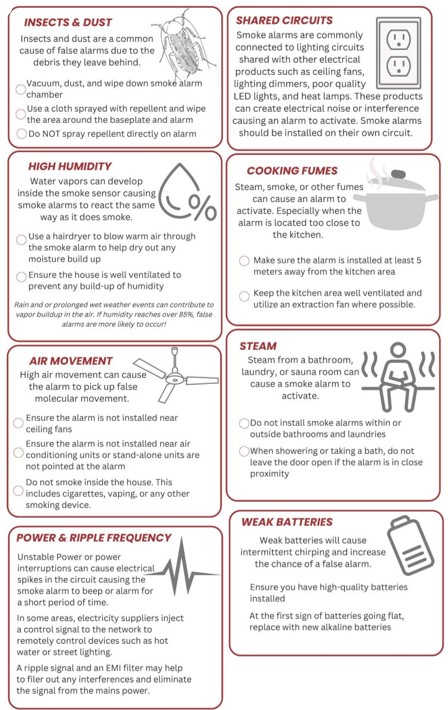Blog
An Alarming Nuisance! – Why Is My Photoelectric Fire Detector Beeping For No Reason?

Nothing is more frustrating than interconnected photoelectric fire detectors going off for no reason (especially at 2am in the morning!). But why is your smoke alarm beeping when there is no smoke? There can be several causes of nuisance alarms. The good news is that you don’t have to go on living this way – our ZEN wireless interconnected photoelectric smoke alarms provide reliable protection for you and your family!
The basic operating principle of an interconnected photoelectric fire detector is that it activates when the light beam inside the smoke alarm chamber is broken or disrupted—typically by tiny smoke particles. However, these foreign particles can come from sources other than real smoke too, such as dust, steam, or aerosols.
Below are some of the most common examples of these interfering particles and practical solutions to resolve them. Understanding the causes of false alarms can help you maintain optimal performance and reduce unnecessary disruptions while ensuring that your alarm responds correctly to actual fire hazards.
High Humidity Affecting Your Photoelectric Fire Detector
High humidity may occur naturally as the air carries dense moisture particles that your photoelectric smoke alarm confuses for smoke particles. Although brands can differ, photoelectric smoke alarms should be designed to work up to 93% relative humidity – anything over this range and the air could become dense enough to scatter the light beam of a photelectric sensor. Extreme tropical weather conditions in far north Queensland and the Northern Territory can sometimes produce high humidity above 85% which may begin to affect an alarm.

High humidity may also be created artificially due to steam vapour from a bathroom shower, or a clothes dryer operating in a laundry room for example. If your photoelectric smoke alarm is positioned outside a bathroom entrance or in a laundry consider moving it further away or relocating it completely so that escaping shower steam and dense air vapour doesn’t trigger nuisance alarms and start the smoke alarm beeping unnecessarily.
Insects Inside Your Photoelectric Fire Detector
Section 4.17 of Australian Standard 3786:2014 requires all photoelectric fire detectors to have protection against foreign bodies, so that a sphere of diameter larger than 1.3mm cannot pass into the sensor chamber – this protection is provided by way of an internal mesh screen. Despite this requirement it is still possible that very tiny insects (smaller than 1.3mm) could enter the smoke alarm and by doing so interfere with the photoelectric sensor. One tip to reduce this likelihood is to wipe the ceiling perimeter around your smoke alarm with surface insect spray (being very careful not to allow the insect spray itself to touch the alarm as this may affect the internal sensors).
Dust Inside Your Photoelectric Fire Detector
A build-up of dust in the air can also affect the performance of your photoelectric fire detectors. When dust particles enter the internal chamber of the smoke alarm, they can interfere with the photoelectric light beam, leading to nuisance alarms. To avoid this, it’s important to clean your photoelectric smoke alarms regularly. We recommend gently vacuuming around them using a soft brush attachment from your vacuum cleaner. This method not only helps remove dust but can also eliminate any cobwebs, preventing pests from entering the alarm and causing malfunctions.
Be mindful of activities in your home that could create excess dust, such as renovations, or shaking out old, dusty blankets and doonas in rooms where a photoelectric fire detector is installed. Regular cleaning and awareness of dust-generating activities can ensure your smoke alarms continue to function properly, reducing the risk of false alarms and maintaining their reliability for years.
Cooking Smoke Affecting Your Smoke Alarm Sensors
It is true that while many house fires start in the kitchen, installing a photoelectric fire detector in or too close to the kitchen can often lead to nuisance alarms. These alarms may go off unnecessarily when smoke particles are emitted from cooking food, even if there’s no real danger. Regardless of the brand of photoelectric fire detector you use, placing it too near the stovetop or oven will trigger the alarm, as it is designed to detect smoke particles in the air. This is a safety feature, but it can be frustrating if your detector goes off due to normal cooking activities.
To prevent these unnecessary alarms, always ensure that the photoelectric fire detector is installed at a safe distance from cooking appliances. When cooking, be sure to use the oven exhaust fan or rangehood to help draw smoky air particles away from the vicinity of the detector. This will reduce the chances of false alarms while still maintaining a safe environment. the problem persists, consider repositioning the alarm further away from the cooking appliance.
Conclusion
Beeping photoelectric fire detectors without an obvious apparent reason can be both frustrating and stress. Repeated false alarms can be more than just an inconvenience—they can lead to a dangerous phenomenon known as the “boy who cried wolf” syndrome. When household members experience frequent, unnecessary alarms, they may begin to ignore the sound of the smoke detector, which could delay or even prevent a timely response during a real fire emergency. This is a serious safety concern, as it reduces the effectiveness of your fire protection system when you need it most.
Fortunately, our ZEN wireless interconnected photoelectric smoke alarms are designed to minimize these risks. They undergo strict quality control measures and are manufactured at an ISO 9001 quality accredited facility, ensuring consistent reliability. In adherence to Australian Standard 3786:2014, our alarms are also independently tested and verified to meet the highest safety standards, significantly reducing the likelihood of nuisance alarms. By following the tips outlined above, you can ensure that your ZEN Smoke Alarms continue to provide many years of stress-free, reliable fire protection, offering peace of mind for you and your family.
For more information about why your photoelectric fire detector is going off no reason, please refer to the handy smoke alarms diagnostic checklist below!

Photoelectric fire detector diagnostic checklist

Want to know more? Watch our ZEN Smoke Alarm YouTube channel or call us on 0478 596 402 today
We love talking smoke alarms!
ZEN Photoelectric Smoke Alarms
New Farm, QLD, 4005
